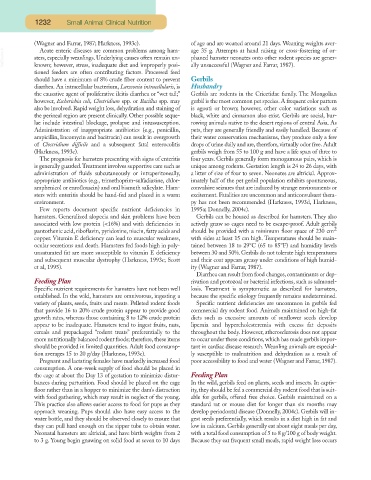Page 1182 - Small Animal Clinical Nutrition 5th Edition
P. 1182
1232 Small Animal Clinical Nutrition
(Wagner and Farrar, 1987; Harkness, 1993c). of age and are weaned around 21 days. Weaning weights aver-
Acute enteric diseases are common problems among ham-
VetBooks.ir sters, especially weanlings. Underlying causes often remain un- age 35 g. Attempts at hand raising or cross-fostering of or-
phaned hamster neonates onto other rodent species are gener-
known; however, stress, inadequate diet and improperly posi-
ally unsuccessful (Wagner and Farrar, 1987).
tioned feeders are often contributing factors. Processed feed
should have a minimum of 8% crude fiber content to prevent Gerbils
diarrhea. An intracellular bacterium, Lawsonia intracellularis, is Husbandry
the causative agent of proliferative ileitis diarrhea or “wet tail;” Gerbils are rodents in the Cricetidae family. The Mongolian
however, Escherichia coli, Clostridium spp. or Bacillus spp. may gerbil is the most common pet species. A frequent color pattern
also be involved. Rapid weight loss, dehydration and staining of is agouti or brown; however, other color variations such as
the perineal region are present clinically. Other possible seque- black, white and cinnamon also exist. Gerbils are social, bur-
lae include intestinal blockage, prolapse and intussusception. rowing animals native to the desert regions of central Asia. As
Administration of inappropriate antibiotics (e.g., penicillin, pets, they are generally friendly and easily handled. Because of
ampicillin, lincomycin and bacitracin) can result in overgrowth their water conservation mechanisms, they produce only a few
of Clostridium difficile and a subsequent fatal enterocolitis drops of urine daily and are, therefore, virtually odor free. Adult
(Harkness, 1993c). gerbils weigh from 55 to 100 g and have a life span of three to
The prognosis for hamsters presenting with signs of enteritis four years. Gerbils generally form monogamous pairs, which is
is generally guarded.Treatment involves supportive care such as unique among rodents. Gestation length is 24 to 26 days, with
administration of fluids subcutaneously or intraperitoneally, a litter of size of four to seven. Neonates are altricial. Approx-
appropriate antibiotics (e.g., trimethoprim-sulfadiazine, chlor- imately half of the pet gerbil population exhibits spontaneous,
amphenicol or enrofloxacin) and oral bismuth salicylate. Ham- convulsive seizures that are induced by strange environments or
sters with enteritis should be hand-fed and placed in a warm excitement. Fatalities are uncommon and anticonvulsant thera-
environment. py has not been recommended (Harkness, 1993d, Harkness,
Few reports document specific nutrient deficiencies in 1995a; Donnelly, 2004c).
hamsters. Generalized alopecia and skin problems have been Gerbils can be housed as described for hamsters. They also
associated with low protein (<16%) and with deficiencies in actively gnaw so cages need to be escape-proof. Adult gerbils
pantothenic acid, riboflavin, pyridoxine, niacin, fatty acids and should be provided with a minimum floor space of 230 cm 2
copper. Vitamin E deficiency can lead to muscular weakness, with sides at least 15 cm high. Temperatures should be main-
ocular secretions and death. Hamsters fed foods high in poly- tained between 18 to 29°C (65 to 85°F) and humidity levels
unsaturated fat are more susceptible to vitamin E deficiency between 30 and 50%. Gerbils do not tolerate high temperatures
and subsequent muscular dystrophy (Harkness, 1993c; Scott and their coat appears greasy under conditions of high humid-
et al, 1995). ity (Wagner and Farrar, 1987).
Diarrhea can result from food changes, contaminants or dep-
Feeding Plan rivation and protozoal or bacterial infections, such as salmonel-
Specific nutrient requirements for hamsters have not been well losis. Treatment is symptomatic as described for hamsters,
established. In the wild, hamsters are omnivorous, ingesting a because the specific etiology frequently remains undetermined.
variety of plants, seeds, fruits and meats. Pelleted rodent foods Specific nutrient deficiencies are uncommon in gerbils fed
that provide 16 to 20% crude protein appear to provide good commercial dry rodent food. Animals maintained on high-fat
growth rates, whereas those containing 8 to 12% crude protein diets such as excessive amounts of sunflower seeds develop
appear to be inadequate. Hamsters tend to ingest fruits, nuts, lipemia and hypercholesteremia with excess fat deposits
cereals and prepackaged “rodent treats” preferentially to the throughout the body. However, atherosclerosis does not appear
more nutritionally balanced rodent foods; therefore, these items to occur under these conditions, which has made gerbils impor-
should be provided in limited quantities. Adult food consump- tant in cardiac disease research. Weanling animals are especial-
tion averages 15 to 20 g/day (Harkness, 1993c). ly susceptible to malnutrition and dehydration as a result of
Pregnant and lactating females have markedly increased food poor accessibility to food and water (Wagner and Farrar, 1987).
consumption. A one-week supply of food should be placed in
the cage at about the Day 13 of gestation to minimize distur- Feeding Plan
bances during parturition. Food should be placed on the cage In the wild, gerbils feed on plants, seeds and insects. In captiv-
floor rather than in a hopper to minimize the dam’s distraction ity,they should be fed a commercial dry rodent food that is suit-
with food gathering, which may result in neglect of the young. able for gerbils, offered free choice. Gerbils maintained on a
This practice also allows easier access to food for pups as they standard rat or mouse diet for longer than six months may
approach weaning. Pups should also have easy access to the develop periodontal disease (Donnelly, 2004c). Gerbils will in-
water bottle, and they should be observed closely to ensure that gest seeds preferentially, which results in a diet high in fat and
they can pull hard enough on the sipper tube to obtain water. low in calcium. Gerbils generally eat about eight meals per day,
Neonatal hamsters are altricial, and have birth weights from 2 with a total food consumption of 5 to 8 g/100 g of body weight.
to 3 g. Young begin gnawing on solid food at seven to 10 days Because they eat frequent small meals, rapid weight loss occurs

